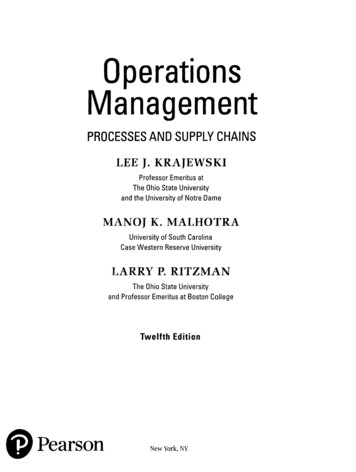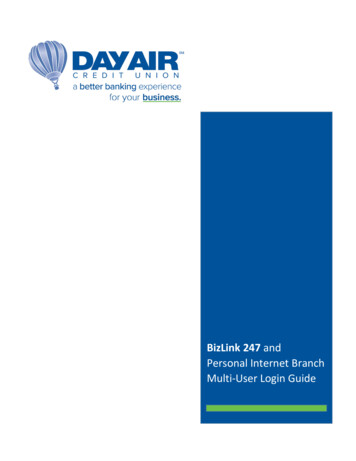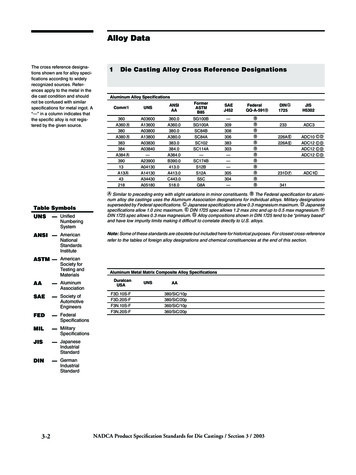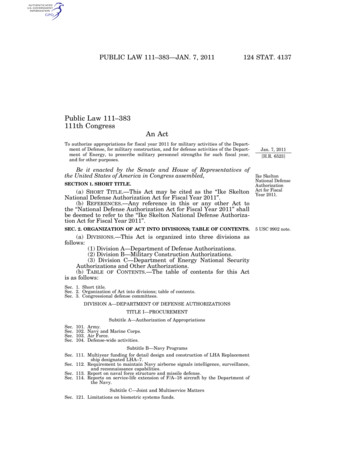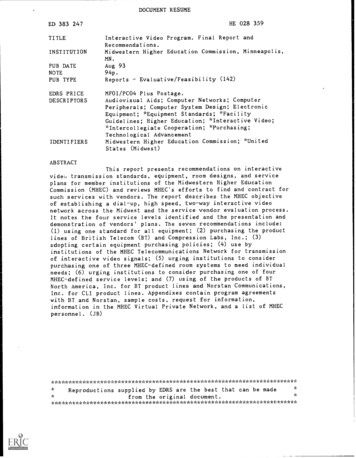
Transcription
DOCUMENT RESUMEHE 028 359ED 383 247TITLEINSTITUTIONInteractive Video Program. Final Report andRecommendations.Midwestern Higher Education Commission, Minneapolis,MN.PUB DATENOTEPUB TYPEAug 93EDRS PRICEDESCRIPTORSMF01/PC04 Plus Postage.Audiovisual Aids; Computer Networks; ComputerPeripherals; Computer System Design; ElectronicEquipment; *Equipment Standards; *FacilityGuidelines; Higher Education; *Interactive Video;*Intercollegiate Cooperation; *Purchasing;Technological AdvancementMidwestern Higher Education Commission; *UnitedStates ity (142)ABSTRACTThis report presents recommendations on interactivevideo transmission standards, equipment, room designs, and serviceplans for member institutions of the Midwestern Higher EducationCommission (MHEC) and reviews MHEC's efforts to find and contract forsuch services with vendors. The report describes the MHEC objectiveof establishing a dial-up, high speed, two-way interactive videonetwork across the Midwest and the service vendor evaluation process.It notes the four service levels identified and the presentation anddemonstration of vendors' plans. The seven recommendations include:(1) using one standard for all equipment; (2) purchasing the productlines of British Telecom (BT) and Compression Labs, Inc.; (3)adopting certain equipment purchasing policies; (4) use byinstitutions of the MHEC Telecommunications Network for transmissionof interactive video signals; (5) urging institutions to considerpurchasing one of three MHEC-defined room systems to meed individualneeds; (6) urging institutions to consider purchasing one of fourMHEC-defined service levels; and (7) using of the products of BTNorth America, Inc. for BT product lines and Norstan Communications,Inc. for CLI product lines. Appendixes contain program agreementswith BT and Norstan, sample costs, request for information,information in the MHEC Virtual Private Network, and a list of MHECpersonnel. *************************Reproductions supplied by EDRS are the best that can be madefrom the original ******************************
MIDWESTERN HIGHEREDUCATION COMMISSIONInteractive Video ProgramFinal Report and RecommendationsPrepared for Institutions of Higher Education and State Agenciesin the MHEC Member States of:Illinois, Kansas, Michigan, Minnesota, Missouri, Nebraska, and OhioThe Midwestern Higher Education CommissionTelecommunications CommitteeAugust 1993"PERMISSION TO REPRODUCE THISMATERIAL HAS BEEN GRANTED BYU S DEPARTMENT OF EDUCATION mu, 01Educational Finsoarch any Imp,overnaniEDUCATIONAL RESOURCES INFORMATIONCENTER (ERIC)lierhis document has been reproduced asMidwestern HigherEducation Commissionreceived from the person or organizationoriginating it1:3 Minor changes nave been made toubprove reproduction qualityPoints of view or opinions staled in thisdocument do not necessarily representofficial OERI position or policyRESOURCES2TO THE EDUCATIONAL(ERIC)."INFORMATION CENTERBEST COPY AVAILABLE
The Midwestern Higher Education Commission (MHEC) was established in 1991 by theMidwestern Regional Education Compact, an interstate agreement among Midwestern states.The current members of MHEC are Illinois, Kansas, Michigan, Minnesota, Missouri,Nebraska, and Ohio.The mission of MHEC is to improve higher education opportunities and services in theMidwest region through interstate cooperation and resource sharing. MHEC programsinclude activities to:produce regional cost savings to benefit all colleges and universitiesexpand student accesssupport public policy development through analysis and information exchangefacilitate regional cooperative academic programmingencourage quality managementpromote economic growth through higher education and industry innovation-""11111-TCAdvancing Education Through CooperationMidwestern Higher Education Commission1300 South Second Street, Suite 130Minneapolis, MN 55454Office: 612-626-8288FAX: 612-626-8290All Rights Reserved.
-4111111411rAdvancing Education Through CooperationCOMMISSIONERSIllinoisRey W. BruneBradley J. BurzyrskiMiriam Lugo-GonzalezMay 25, 1994Laurel PrussingRichard D. WagnerKansasStephen JordanChristine DowneyCindy EmpsonJoan FinneyConnie HubbellMichiganDavid AdamanyArthur EllisDonald GilmerJohn SchwarzWilliam SederburgMinnesotaLyndon R. CarlsonMa lda FarnhamAnne HopkinsConnie MorrisonLeRoy StumpfMissouriGerald T. BrooderDear ColleagueSince the preparation of this report., the State of Wisconsin has joined theMidwestern Higher Education Compact. The Commission is pleased to announcethat the equipment, services and discount prices offered under the MHEC interactivevideo program agreements with British Telecommunications North America (BTNA)and Norstan Communications (CL1) are available to all public and independentnonprofit institutions of higher education in Wisconsin effective immediately.MHEC's other cost savings initiatives and services are now available to Wisconsinhigher education as well.We are very pleased to welcome Wisconsin to the Compact and we lookforward to working with our higher education colleagues on projects mutuallybeneficial to all.Harold L CarkeyKen JacobCharles McClainSincerely,NebraskaRandolph FerlicMartin MassengaleSandra ScofieldRon WithemJerome WarnerDavid MurphyPresidentOhioTimothy CosgroveKaren L GillmorElaine HairstonWayne JonesCharles E. TaylorPresidentDavid MurphySenior AdvisorPhillip Sirotkin4Midwestern Higher Education Commission1300 South Second Street, Suite 130 Minneapolis, Minnesota 55454-1015Fax: (612) 626-8290Telephone: (612) raskaOhio
MHECMidwestern Higher Education Commission1300 South Second Street; Suite 130Minneapolis, Minnesota 55454Telephone: (612) 626-8288Fax: (612) 626-8290Advancing Education Through CooperationAugust 6, 1993Higher Education LeadershipMHEC Member StatesDear Colleagues:We are pleated to present the following report on interactive video transmissionstandards, equipment, room designs and service plans for your consideration. It is theproduct of an intensive six-month effort by the MHEC Telecommunications Committee.The Committee was established by the Commission in 1992 for the purpose of developinginterstate telecommunication initiatives. Its goals are to reduce costs and improve thequality of telecommunication services available to postsecondary institutions and stateagencies in MHEC member states. Committee members are:Kenneth Johnson, ChairCentral Michigan UniversityGregory AsheThe Ohio State UniversityColeman BurtonUniversity of Missouri SystemStephen CawleyUniversity of Minnesota, Twin CitiesKia MalottSouthern Illinois UniversityRuth MichaleckiUniversity of NebraskaDavid MurphyMHECBarbara PaschkeKansas Board of RegentsTwo major, national vendors have agreed to provide MHEC with special discountpricing on interactive video CODECs, MCUs, peripheral equipment, room designpackages, and maintenance programs. These offerings are being made available to allinstitutions of higher education and state agencies in MHEC member states (see Appendices1 and 2).The Commission is very proud of the MHEC Telecommunications Committee'saccomplishments. It is our hope that after reading this report you will share our enthusiasmfor their work. We believe that this program will benefit many colleges and uiniversities inour member states and would appreciate receiving your comments regarding its value. Welook forward to responding to your inquiries in the months ahead.Sincerely,Af/David MurphyPresident/DM/dbEnclosurecc: MHEC riNebraskaOhio
MHEC INTERACTIVE VIDEOPROGRAMFinal ReportBackgroundEvaluation ProcessFindings and Recommendations
Table of ContentsBackgroundEvaluation ProcessFigure 1: Suggested Room OptionsFigure 2: Suggested Service LevelsFindings and RecommendationsCarr StandardsCODEC and MCU EquipmentUniform EquipmentMethod of TransmissionRoom DesignsService and Maintenance ContractsRecommended VendorsSources of Additional InformationAppendicesAppendix 1: Program Agreement withBT North America, Inc.Appendix 2: Program Agreement withNorstan, Inc.Appendix 3: Sample Interactive VideoCommunications Costs Using MHECNetwork for TransmissionAppendix 4: The MHEC Virtual Private NetworkAppendix 5: The MHEC Interactive Video Request forInformation (RFI)Appendix 6: Commissioners and Committees12-63-467-13788891011-121315
MHEC Interactive Video ProgramFinal ReportAugust 1993BackgroundThe Committee: The MHEC Telecommunications Committee was established in 1992to develop interstate telecommunications initiatives on behalf of the Midwestern Higher EducationCommission (MHEC). The Commission seeks to reduce the costs and improve the quality oftelecommunications services available to post-secondary educational institutions and state agenciesthroughout the Midwest. The Telecommunications Committee receives its counsel from anassembly of state representatives and network committees representlig higher education inparticipating states. Its findings and recommendations are submitted to MHEC for implementation,and then made available to all public and private institutions of post-secondary education and stateagencies in MHEC member states. The Telecommunications Committee members are:Kenneth Johnson, ChairCentral Michigan UaiversityGregory AsheThe Ohio State UniversityColeman BurtonUniversity of Missouri SystemStephen CawleyUniversity of Minnesota, Twin CitiesKia MalottSouthern Illinois UniversityRuth MichaleckiUniversity of NebraskaDavid MurphyMHECBarbara PaschkeKansas Board of RegentsThe MHEC Telecommunications Network: The first major program initiative ofthe Telecommunications Committee was the creation of a Virtual Private Network (VPN) fortransmitting voice, data, and video signals. The VPN was established through an agreement withSprint Communications, and is officially known as the MHEC Telecommunications Network. Byusing a "private" portion of Sprint's fiber-optic lines, MHEC participants are able to send digitallycompressed signals across the Midwest and nation at substantially discounted prices. (SeeAppendix 4 for a brochure about the MHEC VPN.)Final Report and Recommendations: MHEC Interactive Video Program Proprietary for Members Only1
The Interactive Video Program: The second program initiative is to implement adial-up, high-speed, two-way interactive video network across the Midwest using the MHECTelecommunications Network. MHEC and the Telecommunications Committee believe thatdistance learning technologies and video conferencing offer many unique opportunities to sharehigh-quality academic programs and services in a very cost-efficient manner. Many institutions ofhigher education in MHEC states are either considering or have already begun implementinginteractive video projects.The objective of the MHEC Interactive Video Program is to make availablelow-cost, two-way interactive video equipment, room designs, and networkservices to institutions and state agencies in MHEC member states. The programrequires high-quality video technology and the most comprehensive service offerings possible tomeet the Midwest's educational communications needs. It seeks to provide the lowest pricingpossible, and make that pricing available to all member institutions and state agencies.Evaluation ProcessPreliminary Analysis: To develop this Interactive Video Program, MHEC firstanalyzed an extensive body of information gathered from similar projects conducted by theMichigan Collegiate Telecommunications Association (MiCTA), the State of Kansas, and the OhioAerospace Institute. MHEC gratefully acknowledges the contributions of these organizations tothe planning of this program.Request for Information: In March 1993, MHEC's Telecommunications Committeeissued a Request for Information (RFI) to numerous national vendors of interactive videoequipment and asked for their written responses. The RFI covered the basic MHEC requirementsfor both the necessary video equipmentChannel Service Units (CSUs), CODECs meeting theCCITT H.261 Standard, and Multipoint Control Units (MCUs) meeting the CCITT H.261Standardas well as classroom and conference room designs. The room designs were to includedetailed information on the audio systems, cameras, and the chairman/instructor controls availablefor use. In all, twelve separate vendors, representing 6 different CODEC manufacturers,responded to this request. (See Appendix 5 for a copy of the RFL)To evaluate these responses, the Telecommunications Committee held a series of meetingsin St. Louis on May 10 and 11, 1993. After briefly discussing the overall objectives of the RFI,evaluation of the responses was separated into three areas: network design, hardware/softwarecapabilities, and room designs. After the initial reading of each proposal, several vendors wereremoved for failing to meet the basic specifications outlined in the RFI. Discussions then centeredFinal Report and Recommendations: MHEC Interactive Video Program Proprietary for Members Only2
around a comparison of the vendors' features, pricing, and total system design capabilities,including such items as proprietary algorithms, encryption, graphics capabilities, available dataports, custom turnkey solutions, "Rollabout" units, and design and consult 'don services. Fromthese discussions, the Committee recommended that three vendors be invited to make formalpresentations to the Committee.During this series of meetings, the Committee composed an initial list of recommendationswith a two-fold purpose in mindto assist the Committee's discussion and evaluation of thevendors' proposals on common terms and products, and to provide MI-IEC members with a"guide" to the complicated decisions surrounding any interactive video purchase. In reviewing allof the original proposals, the Committee identified three potential room designs that memberinstitutions would be most likely to install. These systems were carefully developed in a "stairstep" fashion to ensure that equipment used at one level could be easily reused, upgraded, orreplaced as an institution's needs required (see Figure 1). In addition to these three options, theCommittee included a provision for complete room customization. These room recommendations,in addition to a detailed list of equipment pricing, consultation and design services, and adescription of warranty and repair services, formed the basis of evaluation when the Committeereconvened on June 15 and 16, 1993, to receive vendor presentations.Figure 1: Suggested Room Design Options for Different UsesOption 1: Roll-aroundNumber of people6-10Suggested usesSmall group teleconferences, seminars, andremote site observation.Basic equipmentA self-contained video unit including a camera,monitor, CODEC, and sound system, allhoused in a wheeled cabinet. The unit shouldalso include a type of picture-in-picture (PIP)capability.Suggested optional equipmentDocument camera, VCR, slide unit.Final Report and Recommendations: MHEC Interactive Video Program Proprietary for Members Only3
ption:Roll- around PlusNumber of people12-16Suggested usesTeleconferences, seminars, remote observation,lectures.Basic equipmentSame as above, with addition of documentcamera, additional camera(s), additionalmonitor(s), and an expanded audio system.Suggested optional equipmentOption 3:PIP, VCR, slide unit.lassroomNumber of people16-32Suggested usesLarger teleconferences, seminars, remoteobservation, lectures, and classroom teaching.Basic equipment2 cameras, document camera, CODEC,preview monitors, at least 2 display monitors,and an advanced audio system.Suggested optional equipment3-chip cameras, additional display or previewmonitors, VCR, slide unit, Laser Disc player.The vendors were allotted 2 hours each for their presentations, and were expected to haveresponded in writing beforehand with additional information. Based on the information received inboth the oral and written responses to the Committee's questions and recommendations, thevendors were accepted into the final 2-stage round of the evaluation process. The first stagerequired a written response to the final questions of the Committee, including explanations andclarifications on such points as:Records: The Committee sought to have a copy of all sales, upgrade, and maintenanceinvoices sent to MHEC's headquarters in Minneapolis by the vendor, allowing MHECto collect regional information about the volume and type of activity under theagreement.Regional Treatment: The Committee requested vendor assurances that allannouncements of upgrades, bug fixes, or new products would be sent to allpurchasing sites and MHEC headquarters.Final Report and Recommendations: MHEC Interactive Video Program Proprietary for Members Only411
Upgrade Pricing: The Committee sought a provision where the vendor agrees toprovide all CODEC and MCU related product functionality upgrades at no more thanfive percent above the manufacturer's price to the vendor.Site Consultation Fee: The Committee asked that the vendor agree to credit the cost ofsite consultation services toward the purchase of CODEC/MCU options/equipment androom design packages. The initial site consultation fee was not to exceed 1,500.Low Price Guarantee: The Committee asked that the vendor guarantee that MHECmembers would receive the lowest price for the CODEC and MCU equipment andoptions. If a lower price was bid to any individual MHEC member from any vendor,MHEC's vendor would agree to beat that price offer to all MHEC members.Duration of Agreement: The Committee sought a one year agreement with two oneyear renewal options to guarantee the prices offered on all equipment (CODECs,MCUs, and room designs), and a two year agreement with one one-year renewaloption to guarantee the prices of all maintenance and service agreements.Proprietary Information: The Committee requested that pricing information includedunder the MHEC umbrella agreement be proprietary.In addition to responding to these policies, the vendors were asked to provide pricing for asecond set of Committee-developed recommendations concerning first year warranties and optionallevels of service. For the first year's warranty, the Committee decided to seek a provision which,at no additional cost to the institution, would provide a four hour response time on remotediagnostics, and twenty-four hour response time for on-site diagnostics and service. TheCommittee recommended that this provision begin following on-site delivery, testing and burn-in,and customer acceptance of the equipment. In addition to this warranty provision, the Committeeasked that four optional levels of service be offered by the vendor, tiered much the same way as thesuggested room systems. In this way, the Committee sought to design service levels that weresensitive to each institution's needs and budgets. The four levels are:Level 1: An arrangement where all servicesphone support, remote diagnostics, depotrepair (repair and return), labor, and materialswould be provided at a per-hour or peritem rate.Final Report and Recommendations: MHEC Interactive Video Program Proprietary for Members Only512
Level 2: A low-cost retainer agreement where the vendor provides phone support and afour hour response for remote diagnostics at no additional cost to the customer. Depotrepair (repair and return) would be provided at an additional per-hour rate for labor plusthe cost c,f materials.Level 3: A low-cost retainer agreement where the vendor provides phone support, a fourhour response for remote diagnostics, and a hardware warranty (ship and replace) at noadditional cost to the customer. All time and labor would be provided at an additionalper-hour cost.Level 4: A full-service agreement where the vendor provides phone support, a four hourresponse for remote diagnostics, a hardware warranty (ship and replace), and on-sitetwenty-four hour response at no additional cost to the customer.The second stage of the final evaluation involved a hands-on, side-by-side demonstrationof the BT and CLI equipment. On July 15, 1993, the Committee convened at Central MichiganUniversity. Representatives from each of the vendors were in attendance. Transmissions tookplace between the Committee in Mt. Pleasant, Michigan, and the remote site at North CentralMichigan College at speeds of 112 kbps, 384 kbps, 768 kbps, and full T-1. In addition tooperating between CLI and BT CODECs, the Committee also demonstrated interoperabilitybetween CODECs manufactured by CLI and BT. It was generally agreed that at speeds below 384kbps, the CODECs lacked the clarity of picture or the motion-handling capability for generalclassroom use. At 768 kbps, the Committee agreed that the signals from both the BT and CLICODECs were very suitable for classroom use; at full T-1, the signals of both had closelyapproached broadcast TV quality.After completing the hands-on test, and receiving the final information from the vendors,the Committee met once again via conference call, and issued the following recommendations.Final Report and Recommendations: MHEC Interactive Video Program Proprietary for Members Only613
Findings and RecommendaEons1. The MHEC Telecommunications Committee recommends that MidwesternHigher Education institutions endorse the CCITT H.261 Standard for allCODEC and MCU equipment.The Committc-,;, recognizing that interoperability across the Midwest and the worldis of prime importance to higher education, recommends that MHEC adopt acommon, basic standard for all telecommunications and video transmission.Recommended CCITT StandardsOverallH.320Video Coding11.261, both CIF and QCIF at 30 FPS. Full OF resolution 288 linesx 352 pixels; QCIF 144 lines x 176 pixels.Framing and Signaling Structure11.221SignalingH.242SignalingH.230Audio CodingG.722 (50 to 7000Hz ADPCM) fallback to G.711 (A law or 11 law)(300 to 3400Hz PCM) or G.728 (300 to 3400Hz) user selectable.Video Input/OutputNTSC 525 line 60Hz.Transmission SignalH11 (T-1). 15 way sub miniature D-type interface, and RS-449 37way subminiature D-type interfaceClock rate @1.544 Mbps.Channel Coding. AMUB8ZS per G.703, G.704 and G.733. RS449and RS422 interfaces.Data rates. Selectable between 56/64 kbps and primary port clock ratein 56/64 kbps increments.MCU Audio MixingH.231.MCU Conference ControlH.221 (BAS codes), chairman control (on issue of recommendation byCCITI).Final Report and Recommendations: MHEC Interactive Video Program Proprietary for Members Only71
2. Based on its adoption of the CCITT H.261 Standard, and on its research andevaluation, the MHEC Telecommunications Committee reports that onlyCODECs and MCUs from British Telecom (BT) and Compression Labs, Inc.(CLI) meet both the CCITT Standards and the Telecommunications Committeerequirements. Accordingly, the Committee recommends these two productlines for consideration by colleges and universities.As discussed earlier, several vendors were removed from consideration becausethey did not comply with the endorsed CCITT Standards. For the remainingvendors, comparison of the features, pricing, and total system design capabilitiesplayed an important role.3. In addition to the above CCITT Standards and MHEC requirements, theTelecommunications Committee encourages each institution to purchase theequipment most similar to the equipment at the site(s) most frequentlyaccessed with interactive video technology.The Committee feels very strongly that institutions should purchase the sameCCITT (MHEC) standards compatible equipment most prevalent in the institution'shome state, or the equipment used by the institution's most frequent interactivevideo partner. While the adoption of the CCITT Standards will allow a high qualitysignal to be transmitted between unlike CODECs, the best picture quality (bothsending and receiving) will occur between CODECs of the same brand and model.Multipoint video conferencing is much easier if the CODECs and MCUs are fromthe same manufacturer. Some functionality may be lost when CODECs fromdifferent manufacturers operate at the standard in point-to-point video conferencing,and even more functionality may be lost when CODECs from differentmanufacturers are linked in a multipoint conference.4. The MIIEC Telecommunications Committee recommends that institutions usethe MHEC Telecommunications Network for transmission of their interactivevideo signals where possible.Regardless of whether an institution uses the MHEC VPN to carry its voice or datatraffic, the fiber-optic links of the MHEC VPN offer substantial quality advantagesto participating institutions for interactive video applications. The dial-up capabilityof the VPN, the reduced transmission rates, and the availability of dedicated T-1links make the MHEC Telecommunications Network a competitive solution forinteractive video transmission. MHEC's telecommunications carrier, SprintCommunications, is committed to providing quality network services to MHECFinal Report and Recommendations: MHEC Interactive Video Program Proprietary for Members Only81 :i
members. (See Appendices 3 and 4 for descriptions of the network and the cost ofits use for interactive video transmissions among states.)5. To simplify the complex decisions about room and system designs, the MHECTelecommunications Committee recommends that institutions considerpurchasing one of the three MHEC-defined room systems to meet individualneeds.The maze of cameras, monitors, cabinets, wiring, CODECs, can get very confusingin a short period of time, making even a simple decision to proceed on a small scaleballoon into numerous following decisions. MHEC hopes to simplify at least someof those decisions by defining three common rooms that institutions will be mostlikely to purchase. In addition, of course, institutions retain the option of designingtheir own rooms or having the vendor perform a full customization of any room tomeet the institution's needs. Each of these room systems has specially negotiatedMHEC-member prices.Final Report and Recommendations: MHEC Interactive Video Program Proprietary for Members Only91 i;
Option 1: Roll-aroundNumber of people6-10Suggested usesSmall group teleconferences, seminars, and remote siteobservation.Basic equipmentA self-contained video unit including a camera, monitor,CODEC, and sound system, all housed in a wheeled cabinet.The unit should also include a type of picture-in-picture (PIP)capability.Suggested optional equipmentDocument camera, VCR, slide unit.Option 2: Roll-around PlusNumber of people12-16Suggested usesTeleconferences, seminars, remote observation, lectures.Basic equipmentSame as above, with addition of document camera, additionalcamera(s), additional monitor(s), and an expanded audiosystem.Suggested optional equipmentPIP, VCR, slide unit.Option 3: ClassroomNumber of people16-32Suggested usesLarger teleconferences, seminars, remote observation,lectures, and classroom teaching.Basic equipment2 cameras, document camera, CODEC, preview monitors, atleast 2 display monitors, and an advanced audio system.Suggested optional equipment3-chip cameras, additional display or preview monitors, VCR,slide unit, laser Disc player.6. To simplify the complex decisions about service and warranty plans, theMHEC Telecommunications Committee recommends that institutions considerpurchasing one of the four MHEC-defined service levels to meet individualneeds.Because the size and missions of midwestern colleges and universities variesgreatly, MHEC has tried to remain sensitive to the needs of all sectors of highereducation. Larger institutions, for example, may be comfortable performing theirown service and maintenance, while smaller institutions may be more comfortablecontracting for scheduled service and maintenance. To meet these different needs,the Committee has defined four levels of service for institutional consideration.Each service level takes advantage of specially negotiated MHEC-member pricing.Final Report and Reconunendations: MHEC Interactive Video Program Proprietary for Members Only101
Level 1: An arrangement where all servicesphone support, remote diagnostics, depotrepair (repair and return), labor, and materialswould be provided at a per-hour or peritem rate.Level 2: A low-cost retainer agreement where the vendor provides phone support and afour hour response for remote diagnostics at no additional cost to the customer. Depotrepair (repair and return) would be provided at an additional per-hour rate for labor plusthe cost of materials.Level 3: A low-cost retainer agreement where the vendor provides phone support, a fourhour response for remote diagnostics, and a hardware warranty (ship and replace) at noadditional cost to the customer. All time and labor would be provided at an additionalper-hour cost.Level 4: A full-service agreement where the vendor provides phone support, a four hourresponse for remote diagnostics, a hardware warranty (ship and replace), and on-sitetwenty-four hour response at no additional cost to the customer.7. The MHEC Telecommunications Committee recommends the followingcompanies for institutional consideration in making purchases of CODECs,MCUs, room system packages, or service plans:BT North America, Inc. for BT product linesNorstan Communications, Inc. for CLI product linesAfter careful evaluation of twelve separate vendor proposals, in a series of meetingsand conferences over a period of six months (March to August, 1993), theTelecommunications Committee has selected Norstan Communications and BTNorth America as its vendors of choice to recommend to midwestern highereducation. These two firms have met the standards, guidelines, pricing goals, andservice commitments sought by the MHEC Telecommunications Committee in itsRequest for Information. Each has agreed to offer all (501(c)3) colleges,unive
The Interactive Video Program: The second program initiative is to implement. a dial-up, high-speed, two-way interactive video network across the Midwest using the MHEC Telecommunications Network. MHEC and the Telecommunications Committee believe that distance learning technologies and video conferencing offer many unique opportunities to share


